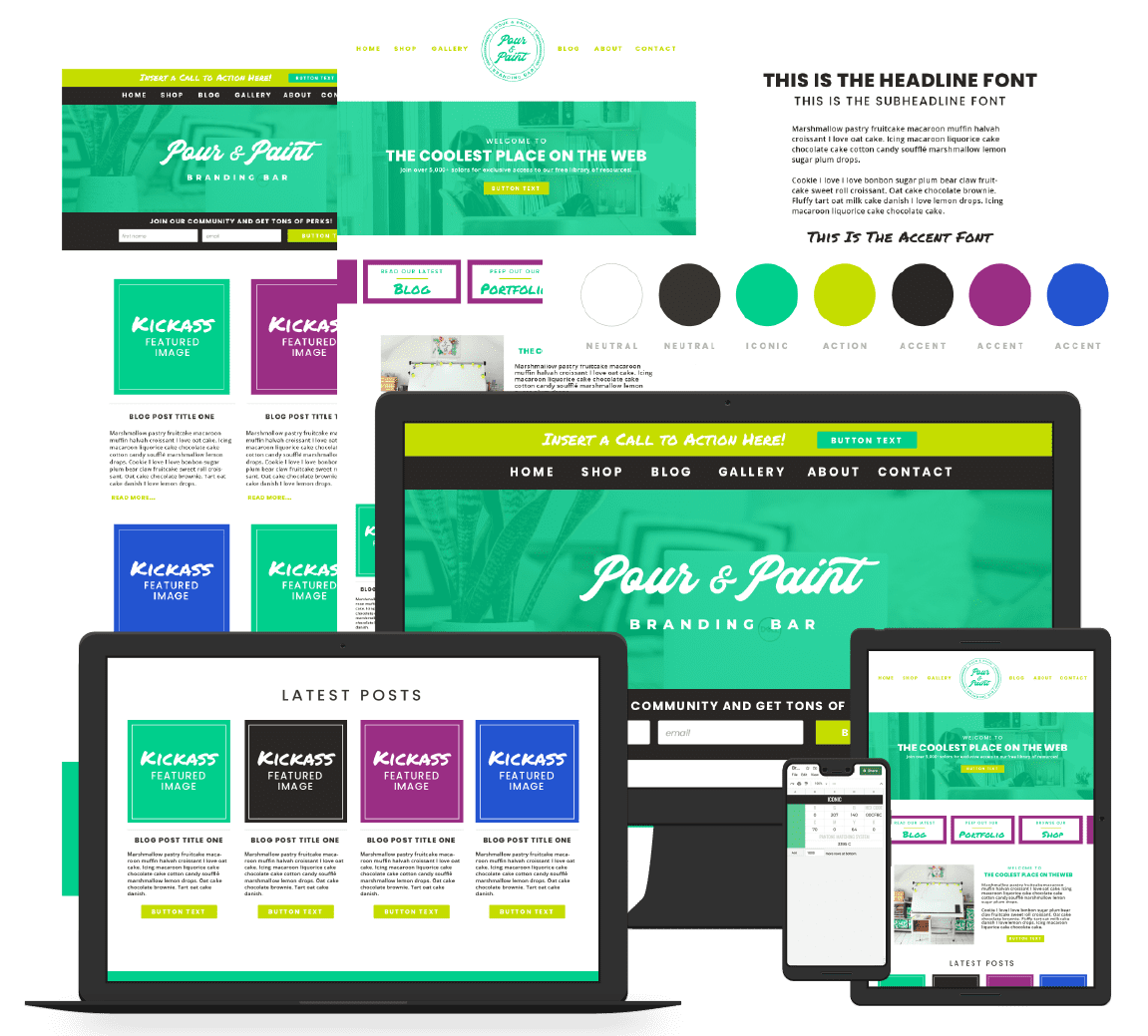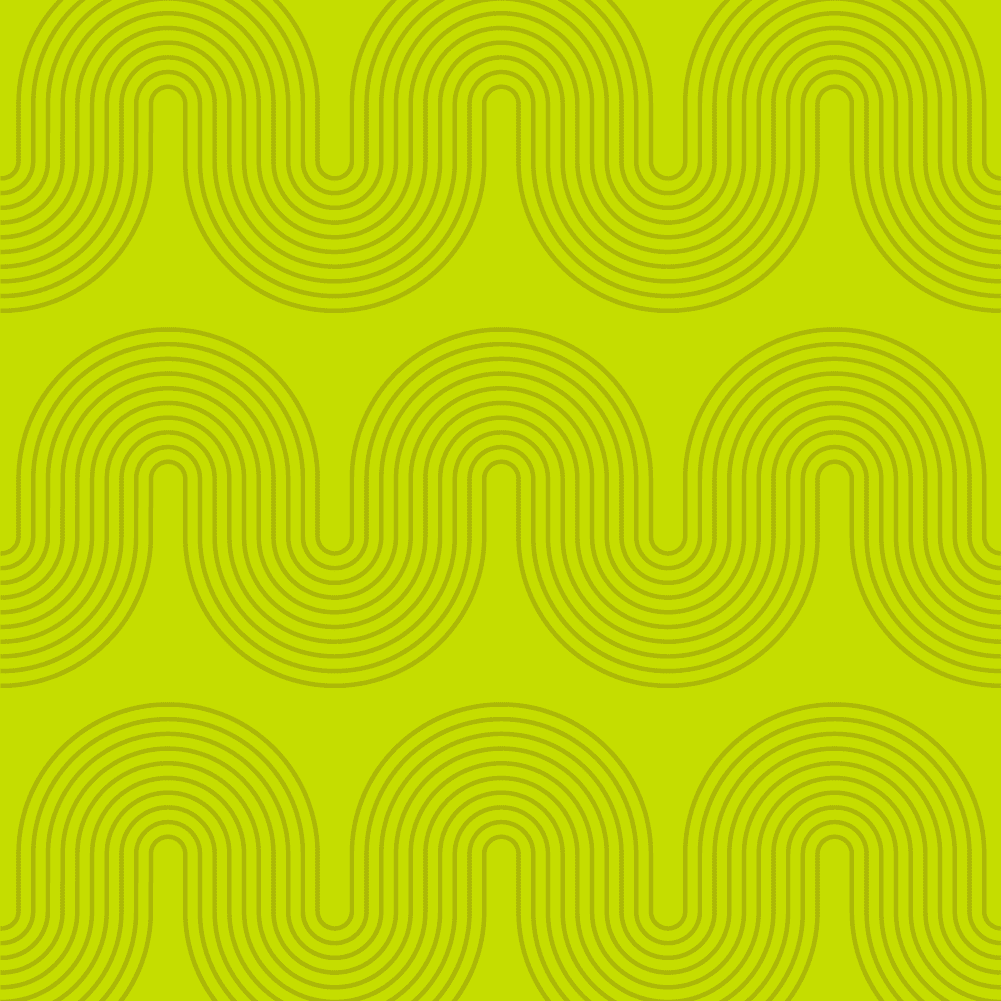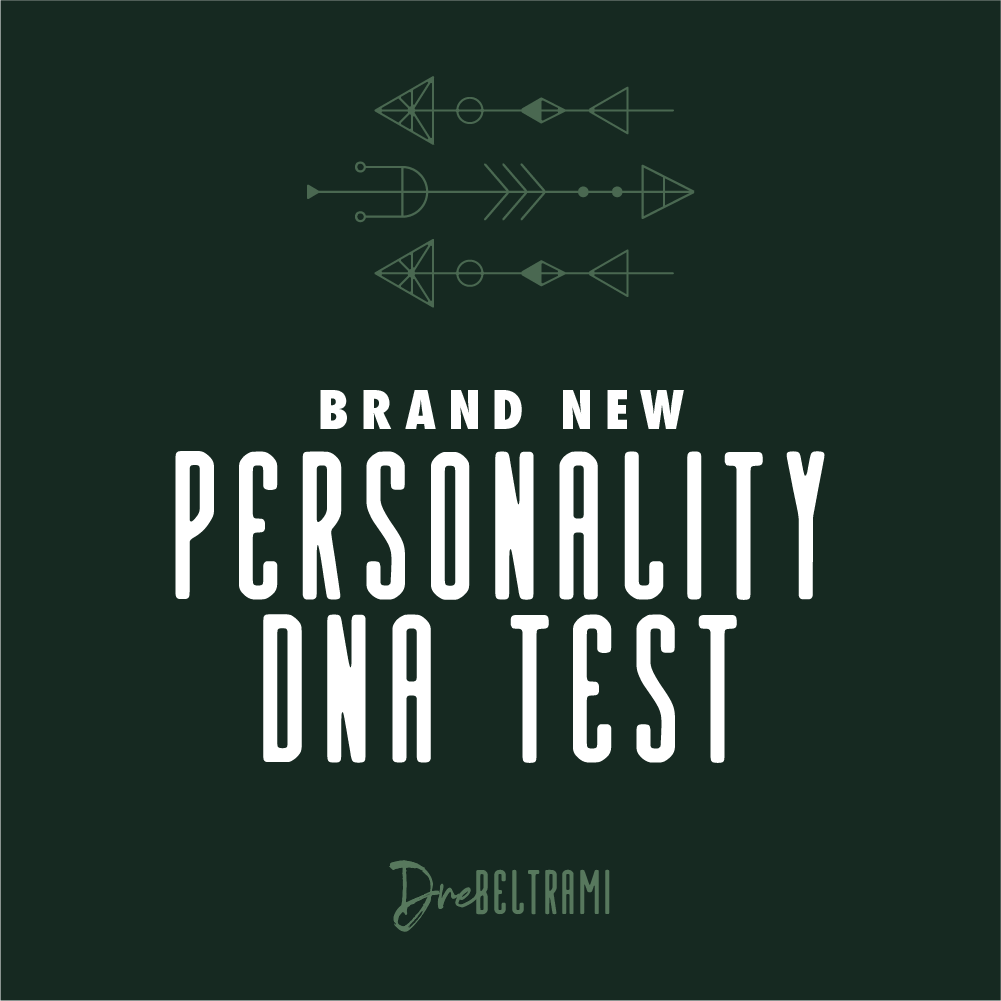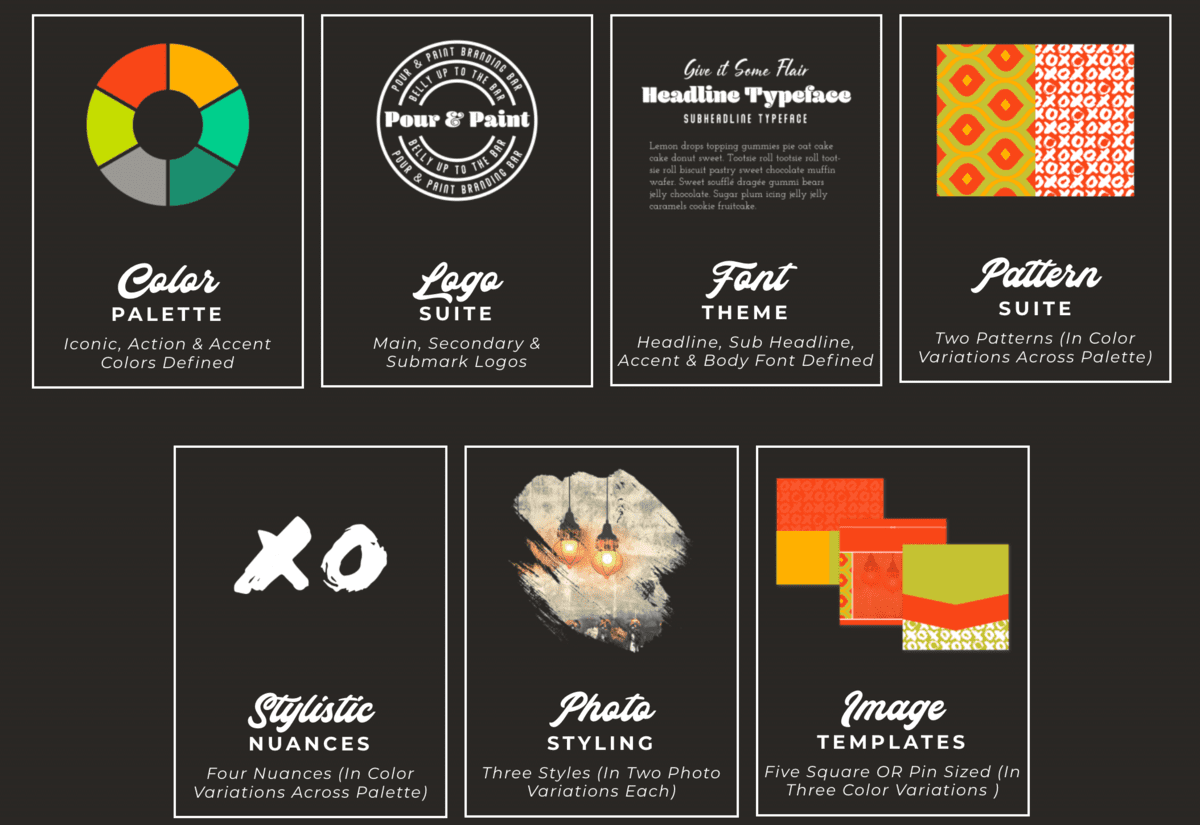
BRAND ACCESSORIES
HOW TO TURN A Simple DESIGN ELEMENT INTO A STATEMENT PIECE FOR YOUR BRAND IDENTITY
The only real difference between a cocktail you make at home and one you drop $24 dollars on is the experience and the ambience it’s consumed in.
That slice of grapefruit and sprig of rosemary that garnishes your $24 cocktail is there to give you a visual cue about, not only what’s in the glass itself but also, the entire experience you’re meant to feel like you’re indulging in.
Brand accessories are the garnishes of your brand identity. They're the finishing touches that’ll give your content visual cues about, not only your subject matter but also, the real-world atmosphere you want people to feel like they're walking into when they're hanging out in your corner of the internet.
written by: DRE BELTRAMI
reading time: 5 minutes
5 TYPES OF BRAND ACCESSORIES
Every iconic + instantly recognizable brand has a legendary collection of one-of-a-kind design accessories that, when paired with their logos, colors, fonts, and patterns, make their brand’s identity 10x’s more useable, versatile, and distinct. 👈 what I want for you!
In the final lesson in this series, I’m going to show you how to turn five simple design elements into brand accessories that are so statement-piece quality that they become your signature trademark... because being so memorable people can't help but see your brand colors and immediately think of you takes attention to detail.
It's the deceptively simple design details that give your brand identity the finishing touches it needs to reinforce the context (a.k.a visual cues) that your logos, colors, fonts, and patterns are meant to represent. Orange on its own is just a color, but orange in the context of the specific style of the real-world place you're channeling is an experience.
Using a ton of style + usage examples let's run through the five options you have for design elements and how to choose the right two for you brand, starting with most accessible brand accessory of them all…
1. shape-FRAMEs
Think of shape-frames like it’s signage because that’s how you would use it… for the most part. I’ll show you what I mean in a minute.
When you’re noodling over what kind of shape frame would work best for your brand’s identity, pull creative direction from the real-world atmosphere you picture your brand living in. Mentally or literally (in real life or through photos) survey every single item that’s located in that space.
Let’s survey a spot and I’ll explain what I mean.
Let’s pretend the oasis in the photo below (a cafe in Mexico) is the type of style and atmosphere that I'm channeling for my brand’s identity, and that I’ve already chosen the colors, logos, fonts, and pattern below the photo. All that’s left to complete my brand wardrobe are some legendary brand accessories.
Click any image tile below to eye-guzzle the full size image





Let’s survey this space for ideas + inspiration...
I see a lot of lines - in the canopy + ceiling, the outdoor heater, the window panes, the counter, the wood paneling, the chairs, the hanging basket lights + decor, the flooring… you get the picture. Scroll back up and survey for yourself.
Not all of the lines are straight but the space as a whole has this great juxtaposition between the very linear nature of the architecture and decor vs. the very organic nature of all the plant life, so that’s something to think about.
As far as shapes themselves go, there’s a large variety used in this space. You have squares + rectangles on the counter, menu, and some of the tables, but 95% of the hanging lights and decor are a rounded shape.
HERE'S WHAT I WOULD DO...
Seeing as each existing brand identity piece in my brand wardrobe (scroll back up for a refresher) really plays up the linear vs. organic juxtaposition I just mentioned, if I think about how, when, and where these specific pieces are going to be used (which we covered in great detail in the last four installments in this series) I would look for a shape-frame that's geometric because the pattern I've chosen is so organic that the contrast with something geometric would be striking.
I could go for something square or rectangle but one of the most eye-grabbing elements in this entire space is the hexagon-shaped trellis hanging from the ceiling. That's a design element I definitely want to pull from because it's such a statement piece.
A good rule of thumb, if it’s a statement piece in the real-world space you're channeling, you can (and probably should) make it a statement piece in your brand identity.
For the fictitious brand identity I'm creating for myself in this lesson (using the photo inspiration above) I'm thinking about a set of shape-frames like this to bring out that statement piece…




WAYS TO STYLE + USE YOUR
BRAND shape-frames
Here's a closet full of of brand styling ideas that you can use to turn your shape-frames into statement pieces on your website and across your content (if you choose to add this accessory to your brand wardrobe).
Click any image tile below to eye-guzzle the full size image






HERE ARE SOME EXAMPLES OF
LEGENDARY shape-frame SETS
TO GET YOUR CREATIVE JUICES FLOWIN'












2. ICONOGRAPHY
Think of iconography like it’s wall art, because that’s how you would use it… for the most part. I’ll show you what I mean in a minute.
When you’re noodling over what kind of iconography would work best for your brand’s identity, pull from either your subject matter or the artistic pieces in the real-world space you’re channeling.
These two approaches are simple, but let me give you some examples.
APPROACH NO. 1
The first way to approach iconography is to use real-world decor-type icons to reinforce the type of space you want people to feel like they’re walking into.
I love this approach because you can tie elements in the space you’re channeling to different elements in your content, which really strengthens the vibe you’re creating.
HERE'S WHAT I WOULD DO...
For the brand identity I'm building in this lesson, I would use different elements you’d find at a cafe (like the one I’m channeling) - maybe a teabag, a teacup, a tea leaf, and a to-go bag - and assign each one to a different parts of my brand. Then, inside those different areas I could exclusively use and creatively lean into the icon assigned.
For instance, if I assigned the tea leaf to my starter course, I could thread a connection between the process of cultivating tea leaves and the process of cultivating a brand. In all the slide deck lessons and PDF guides, even in the framework I used to teach my process, I could use the tea leaf icon in different ways.
For my blog, I could assign the teabag icon and write my posts or shoot my videos like I'm sippin' my morning tea while I drop some knowledge and bust some bullshit. I could use the icon itself as bullet points in the posts, a watermark in the featured images, and in the background of the call to actions.
And on goes the iconography assignment...
You get the drift. I'm thinking about something along the lines of this iconography set...

APPROACH NO. 2
The other approach you can take with your iconography is to use topical icons to reinforce the different parts of your subject matter.
I love this approach because it says volumes about your content without uttering a word, which is great for scrollability and curiosity. I’ll drop some examples of subject matter iconography sets I’ve created for clients below so you can see this approach with your own eyes.
HERE ARE SOME EXAMPLES OF
LEGENDARY ICONOGRAPHY SETS
TO GET YOUR CREATIVE JUICES FLOWIN'
BECKANNY WOLFE



SAMADHI HEALTH
davalt optical
dying kindness
ONE MORE THING. and this is huge!
Regardless of which approach you take you still want to find icons that fit the overall style you’ve defined.
In other words, if you’re using hand-drawn elements in your logo, font, and pattern suites, then the lines of your iconography should have a hand-drawn quality to them. If you’re using grunge-type elements in your logo, font, and pattern suites, then the lines of your iconography should have a grunge-type quality to them.
As far as how many icons you should choose, the general rule of thumb I use is… however many you want AS LONG AS you know how, when, and where you’re using them. I wish I could be more exact but it totally depends on the brand.
Some brands lean more towards lifestyle so they have quite a few sub-topics under their main area of expertise. E.g. A minimalist who covers living spaces, nutrition, wardrobe, traveling, etc., or a chef that teaches about 8 different types of cuisine.
Some brands have multiple products in their product suite. E.g A funnel strategist who has a shop full of digital courses, or a photographer with tons of possible add-ons.
What’s matters the most is relevancy so choose as many icons as you need… and add more as you need them. The iconography police were disbanded decades ago.
WAYS TO USE + STYLE YOUR
BRAND ICONOGRAPHY
Here's a closet full of of brand styling ideas that you can use to turn your iconography into statement pieces on your website and across your content (if you choose to add this accessory to your brand wardrobe).
Click any image tile below to eye-guzzle the full size image









CHOOSING YOUR BRAND ACCESSORIES
Part of choosing the right brand accessories is trying on different ones so you can see, with your own eyes, how things will look "out in the wild" before you make any decisions, which means a proper romp in a "virtual fitting room" is in order...
TEST DRIVE YOUR accessories
SO YOU CAN SEE WITH YOUR Own Eyes WHAT THEY'LL LOOK LIKE IN THE WILD

Welcome to your
Brand Identity Fitting Room
Your own virtual loft, where you can try on and style-proof each and every asset as you design your brand identity to make sure everything comes together like the hand-crafted masterpiece you’re going for.
Defining a specific caricature for your brand is a great way to humanize your content without using photography (your own or stock) but you have to approach them with intention.
I like to think of characters like they're the people buzzing around my inspiration space and those people come in three forms when it comes to brand characters...
If you choose to use a character type of design element in your brand identity the most important thing is to honor the intent you've chosen.
If you're going for a representation of yourself you need to make sure that the set of characters you choose not only looks like you but also captures your personality (a.k.a archetype) and ties into the style of the inspiration place you're channeling, otherwise it'll feel cheesy or out of left field. For instance, if you're a caregiver archetype channeling a tea detox studio choosing a set of playful, hand-drawn, child-like stick figures doesn't make much sense.
If you're going for a representation of your kindreds (a.k.a ideal customers) you need to make sure that the set of characters you choose accurately represents, physically, stylistically, and culturally, the diverse group of people who buy from you, otherwise it's not going to connect, it might even turn off people (who don't fit the caricature you've chosen).
If you're going for a mascot or a sidekick you need to make sure that the set of characters you choose captures the personality you want. Unpack what energy that you vibe off the best and create an entire character around that. Give them a name and tons of ooey, gooey human traits, emotional quirks, and entertaining imperfections, and you could turn this figment of your imagination into the Sonny + Cher of your industry. I call this the Sidekick Strategy, and it's an ingenious way to humanize a company of one (that's you) who wants the feel of having a partner in crime without having to deal with an actual living, breathing, partner.
Obviously, this isn't one of the easiest brand accessories to source out and incorporate but creativity opens a lot of doors, so think outside the box. Characters don't have to be literal illustrations (which are very hard to find in "stock" form), they can also be abstract in a variety of ways - silhouettes, line drawings, stick figures, and the list goes on.
HERE'S WHAT I WOULD DO...
For the identity I'm building in this lesson, I'd go for a character set that's a representation of me, so I can reinforce my voice and personality in my content.
Style wise, when I look at the branding pieces (not any accessories, just the main pieces) that are already in my wardrobe, if I was going to add a character set I'd look for one that shares the same curved line work in the brand pattern I've chosen. In the space I'm channeling it's the plant matter and people (not pictured) that bring the organic elements to the space so for my identity I want the pattern and character to provide the same.
I found this set, which includes a ton more long haired women (who look like me - ok, if I preferred tea over wine) in different poses and activities, that I think would work perfectly...
REPRESENTATION OF ME



HERE ARE SOME EXAMPLES OF
LEGENDARY CHARACTER SETS
TO GET YOUR CREATIVE JUICES FLOWIN'
REPRESENTATION OF KINDREDS



MASCOT OR SIDEKICK



REPRESENTATION OF YOU



REPRESENTATION OF KINDRED



WAYS TO USE + STYLE YOUR
BRAND CHARACTERS
Here's a closet full of of brand styling ideas that you can use to turn your characters into statement pieces on your website and across your content (if you choose to add this accessory to your brand wardrobe)
Click any image tile below to eye-guzzle the full size image






If we were making a drinking game out of how many times I've said atmosphere (or some variation of the sentiment) in this series we'd be having one wild and crazy slumber party tonight, but I can't help it because that place is how you turn your content into a delightfully memorable (visual) experience that's almost instantly etched into people's long-term memories.
There's no better way to recreate the vibe of your inspiration space across the content in your digital world than to pull real-world items out of this space and turn them into brand accessories.
When you’re noodling over what kind of atmosphere decor would work best for your brand’s identity, rip creative direction straight out of your real-world inspiration space. When you survey this space what types of lighting, knick-knacks, wall hangings, plant life, shelving, views, etc. do you see? That's where you'll find all the inspiration you need.
If I use this brand accessory in an identity I typically choose two decor sets (e.g. a lighting set + a hanging plant set, or a cocktail serving set + a bar cart set). The most important thing, no matter how many decor sets you include in your brand identity, is to make sure that every set shares the same design aesthetic. You don't want to use a hand-drawn lighting set and then a flat illustration hanging plant set, that's like drinking OJ right after you brush your teeth - somethings just don't go together.
HERE'S WHAT I WOULD DO...
For the brand identity I'm creating in this lesson, I would pull out two of the most dominant decorative elements in my inspiration space - the hanging decor, specifically the lights + plants - and turn those into brand accessories.
The plant life is such a huge part of what makes this space speak so hard to me that it goes without saying that the subtle representation of it in the pattern I've chosen is not enough. I also want my content to have the same "cozy embrace of nature" feel that my inspiration space has, which I think is in large part to the hanging elements that make it feel so restorative.
After finding the lighting + hanging plant sets below and drenching them in my color palette I think they look fantastic. Notice that they aren't literal matches to the lighting and plant life in my inspiration space, but they capture the same spirit and aesthetic.


HERE ARE SOME EXAMPLES OF
LEGENDARY ATMOSPHERE DECOR SETS
TO GET YOUR CREATIVE JUICES FLOWIN'












WAYS TO USE + STYLE YOUR
your ATMOSPHERE DECOR
Here's a closet full of of brand styling ideas that you can use to turn your atmosphere decor into statement pieces on your website and across your content (if you choose to add this accessory to your brand wardrobe)
Click any image tile below to eye-guzzle the full size image






The last, but certainly not least, option you have for brand accessories is a line work-type of design element, which I like to think of as architectural features in your brand identity because that's how you're going to end up using them... for the most part. I'll show you what I mean in a minute.
Just like the arches in a Spanish or Moorish-style home, line work design elements aren't structurally necessary, but they do speak volumes when it comes to recreating the style of your inspiration space. Would a spanish-style house still look like a spanish-style house if you took out all the arches? Probably not.
When you're noodling over what line work-type of design element would work best for your brand identity, pull inspiration from the architectural elements and linear statement pieces in your inspiration space.
HERE'S WHAT I WOULD DO...
For the brand identity I'm creating in this lesson, I would pull from all the geometric shapes in the architectural elements of my inspiration space and choose a set of line work design elements that pull together a lot of these different shapes.
I love the 3-piece set below, not only because it's geometric but also, because it pulls in the triangles and circles from the hanging decor, which brings the linear and organic elements of my inspiration space together in this one simple design element.
I also love the pure, unadulterated versatility of a line work set like this because I can use the elements like they're pictured below or I can break individual pieces out and use them as I see fit. Skies the limit, baby, which is what you want out of a brand accessory.



HERE ARE SOME EXAMPLES OF
LEGENDARY line work SETS
TO GET YOUR CREATIVE JUICES FLOWIN'












WAYS TO USE + STYLE YOUR
your LINE WORK
Here's a closet full of of brand styling ideas that you can use to turn your line work into statement pieces on your website and across your content (if you choose to add this accessory to your brand wardrobe)
Click any image tile below to eye-guzzle the full size image






MY BRAND ACCESSORY DIRTY LITTLE SECRET
Through out this lesson I've referenced "sets", in one context or another, and that's because they're the easiest way to source out design elements with the same stylistic aesthetic - which matters when it comes to brand accessories... if you want them to be functional, versatile, and distinct.
Whether you choose to add a shape frame, iconography, character, architectural decor, or line work design element to your brand identity there's one place that probably has what you're looking for, Adobe Stock (👈 that's an affiliate link), which just so happens to be my dirty little brand identity secret.
Adobe Stock, which offers a 30-day free trial, is loaded with photography, design elements, fonts, and videos that are 100% legal to use for commercial (a.k.a branding) purposes. Fire up the link I dropped above and give it a test-drive. Type in [subject matter] icons, or line drawing of woman working out, or retro line elements... if you can search it, you can find it!
I DOUBLE-DOG-DARE YOU TO...

Give yourself permission to visually test-drive without censorship, while you handcraft a brand style that's as original as your fingerprint and as recognizable as your face. It's not the pieces in your brand wardrobe that makes you memorable, it's how, when, and where you use the pieces. Bring the style and the eyes will follow.
And hey, once you’ve landed on a fully-stocked, fully-functional, and fully-style-proofed brand wardrobe, I double-dog-dare you to hopscotch over to The Solopreneur Society Support Lounge and drop some of your eye candy, so the crew and I can shower you in high fives and happy dances.
if you prefer to skip the heavy clicking
ditch the diy
for a day with dre!
that's me 👆

belly up to the
BRANDING bar
AND I'LL TAKE YOU THROUGH THE ENTIRE TASTING PROCESS
Because creating a legendary brand identity doesn’t have to break your balls, your budget, or your spirit - and, no, you don’t have to cave on originality either!








